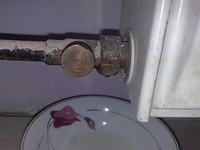Hello all.
In the summer I did a renovation, so I dismantled all the radiators, after the renovation they returned to their place, one turned out to be resistant - it is the bottom flare nut that is leaking. The connections are cone, I don't know how to seal it.
I would like to add that replacement is not an option - they started to heat up.
If anyone knows, please give me solid advice.
Greetings.
In the summer I did a renovation, so I dismantled all the radiators, after the renovation they returned to their place, one turned out to be resistant - it is the bottom flare nut that is leaking. The connections are cone, I don't know how to seal it.
I would like to add that replacement is not an option - they started to heat up.
If anyone knows, please give me solid advice.
Greetings.




